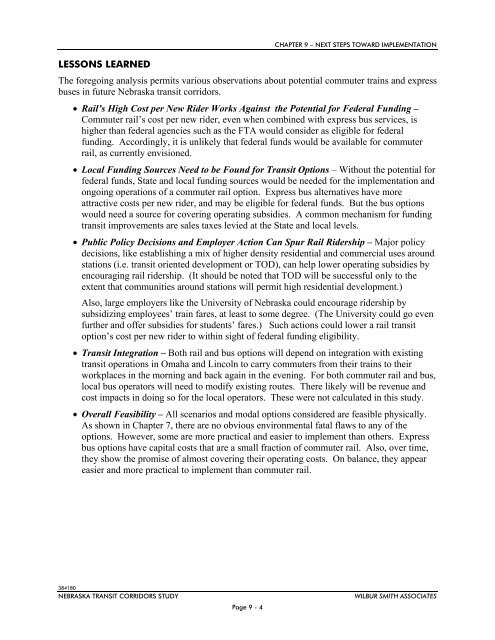NTRAC Final Study - Nebraska Department of Roads - State of ...
NTRAC Final Study - Nebraska Department of Roads - State of ...
NTRAC Final Study - Nebraska Department of Roads - State of ...
You also want an ePaper? Increase the reach of your titles
YUMPU automatically turns print PDFs into web optimized ePapers that Google loves.
CHAPTER 9 – NEXT STEPS TOWARD IMPLEMENTATION<br />
LESSONS LEARNED<br />
The foregoing analysis permits various observations about potential commuter trains and express<br />
buses in future <strong>Nebraska</strong> transit corridors.<br />
Rail’s High Cost per New Rider Works Against the Potential for Federal Funding –<br />
Commuter rail’s cost per new rider, even when combined with express bus services, is<br />
higher than federal agencies such as the FTA would consider as eligible for federal<br />
funding. Accordingly, it is unlikely that federal funds would be available for commuter<br />
rail, as currently envisioned.<br />
Local Funding Sources Need to be Found for Transit Options – Without the potential for<br />
federal funds, <strong>State</strong> and local funding sources would be needed for the implementation and<br />
ongoing operations <strong>of</strong> a commuter rail option. Express bus alternatives have more<br />
attractive costs per new rider, and may be eligible for federal funds. But the bus options<br />
would need a source for covering operating subsidies. A common mechanism for funding<br />
transit improvements are sales taxes levied at the <strong>State</strong> and local levels.<br />
Public Policy Decisions and Employer Action Can Spur Rail Ridership – Major policy<br />
decisions, like establishing a mix <strong>of</strong> higher density residential and commercial uses around<br />
stations (i.e. transit oriented development or TOD), can help lower operating subsidies by<br />
encouraging rail ridership. (It should be noted that TOD will be successful only to the<br />
extent that communities around stations will permit high residential development.)<br />
Also, large employers like the University <strong>of</strong> <strong>Nebraska</strong> could encourage ridership by<br />
subsidizing employees’ train fares, at least to some degree. (The University could go even<br />
further and <strong>of</strong>fer subsidies for students’ fares.) Such actions could lower a rail transit<br />
option’s cost per new rider to within sight <strong>of</strong> federal funding eligibility.<br />
Transit Integration – Both rail and bus options will depend on integration with existing<br />
transit operations in Omaha and Lincoln to carry commuters from their trains to their<br />
workplaces in the morning and back again in the evening. For both commuter rail and bus,<br />
local bus operators will need to modify existing routes. There likely will be revenue and<br />
cost impacts in doing so for the local operators. These were not calculated in this study.<br />
Overall Feasibility – All scenarios and modal options considered are feasible physically.<br />
As shown in Chapter 7, there are no obvious environmental fatal flaws to any <strong>of</strong> the<br />
options. However, some are more practical and easier to implement than others. Express<br />
bus options have capital costs that are a small fraction <strong>of</strong> commuter rail. Also, over time,<br />
they show the promise <strong>of</strong> almost covering their operating costs. On balance, they appear<br />
easier and more practical to implement than commuter rail.<br />
384180<br />
NEBRASKA TRANSIT CORRIDORS STUDY<br />
Page 9 - 4<br />
WILBUR SMITH ASSOCIATES

















